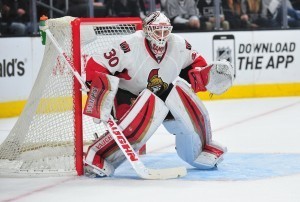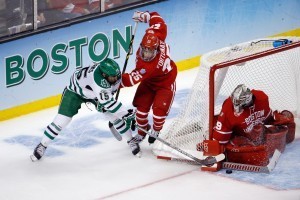Last week, the Ottawa Senators agreed to terms on a three-year contract with late-season goaltending sensation Andrew Hammond. For a goalie who posted an all-situation Sv% of 89.8% through 25 AHL games before moving up to the NHL, this is a pretty impressive deal with Hammond’s contract carrying an AAV of $1.35M.
Breaking: #Sens agree to terms with goaltender Andrew Hammond on a three-year contract extension ???
— Ottawa Senators (@Senators) May 20, 2015
The Senators may have found money in Hammond, but there’s no small amount of risk in retaining him when they’ve got Craig Anderson and Robin Lehner on one-way contracts as well. (Reminder: a one-way contract does not mean that Hammond has to play at the NHL level, only that if he’s in the AHL he will be making a NHL salary.)
Anderson has been a reliable starter for years — he ranks sixth in even strength Sv% among goaltenders who’ve played at least 30 games over the last three seasons — and Lehner is the clear inheritor of the mantle, with more experience than Hammond and he’s three years younger.
Anderson has been fairly consistent, if not a little prone to injuries, and while Lehner’s 91.7% even strength Sv% over the last three seasons is a step down from Anderson’s 93.2%, it’s certainly a tic in Lehner’s column that his high danger save percentage (Sv%H) of 84.2% is above Anderson’s 83.5%. It’s notable because Sv%H is often indicative of repeatable success. So, while Lehner hasn’t taken a starter’s minutes, he’s showing some good signs of future success.
All Good So Far
Having Hammond as a third NHL ready goaltending option is a big win for the Senators, who surprised with a late-season push that not only featured great goaltending, but a shift of the roster focus toward the young core of the team. So, while I’d contend that this is a solid pay day for a 25-game sample — he’ll be making more than Frederik Andersen, Antti Raanta, Jhonas Enroth, or Thomas Greiss, with none of those contracts being ELCs — this contract is a win for Ottawa.
However, it’s a win with an asterisk. It requires them to take some kind of action. If it doesn’t happen over the summer, it probably shouldn’t be too far into the season. They’re dealing with three NHL goaltenders. Hammond makes a very acceptable amount for a back-up, while Lehner makes nearly double what Hammond makes and Anderson makes nearly double what Lehner makes.
If Hammond can prove himself to be a reliable back-up, Ottawa is dealing from a position of power. They could comfortably move Lehner and bolster the team’s depth through trading a promising, young back-up netminder. Or, should Lehner prove himself up to the starter job and Hammond is a reliable back-up, then they could deal Anderson.
Trading Anderson would bring back some big prospects or a big name and would clear $4.2M in cap space over the next three years. In the next two years the Senators will have contract talks with Curtis Lazar, Mike Zibanejad, Alex Chiasson, Mike Hoffman, Jean-Gabriel Pageau, Mark Stone, and Patrick Wiercioch. That extra cap space could come in handy.
But, this plan is contingent on Hammond being NHL-ready.
The Risk For Ottawa
Prior to his late-season heroics, Hammond had played 25 games in the AHL, posting a paltry 89.8% Sv% and allowing 20 goals in his last five AHL starts before getting called up when both Anderson and Lehner were injured. He had a great run at the end of the season, but the undrafted goaltender is 27 and doesn’t have a track record that screams he’s a sure thing.

He almost single-handedly gave Ottawa a playoff berth, but we also started to see the seams in the playoffs.
A trade from a position of power with three NHL goaltenders is fantastic, but a trade is a vote of confidence that seems reactionary. A trade is a vote of confidence in that tiny sample of games, which is really even smaller if you cut out the games where he struggled at the end of the season.
This is a young team with two solid goaltenders right now. Next season the Senators are poised to have a huge portion of their production created by great young players who appear ready to make a push to be a perennial contender. Cutting out their most promising young goaltender in Lehner through a trade might be cashing in on what could be a very temporary embarrassment of riches.
Understanding what they have or making any move of any kind will be contingent on Lehner being healthy. He suffered a concussion in February and is reported to still be experiencing symptoms. However, Bruce Garrioch of the Ottawa Sun says that the team expects him to be healthy at the start of the season.
Pierre Dorion says Robin Lehner is working out and they expect him to be ready for camp. #Sens
— Bruce Garrioch (@SunGarrioch) May 20, 2015
To the Future
The Senators aren’t without more goaltending prospects. They were able to land Matt O’Connor, the 23-year-old undrafted goaltender out of Boston University, this summer. O’Connor was one of the top college free agents hitting the market after the Frozen Four.

He’s exciting, but he’ll need some seasoning and it’s tough to say you can bank on him being your guy when he hasn’t played at the professional level and really struggled on the big stage, allowing some very ugly goals during the Frozen Four that may have cost Boston University the championship. It’s easy to focus on that rough tournament though, which was, in the long-run, just a small sample. He posted an impressive .927 Sv% for BU last season. (Here’s a piece about what Ottawa should expect from O’Connor).
Marcus Hogberg is also an interesting prospect, but at age 20, he’s a little ways off. (He’s also huge at 6-foot-5, 209.) A little further along maybe is Chris Driedger, who made his NHL debut this season and, though he only played eight games, was AHL Binghamton’s leading goaltender in Sv% at .923. Though that assessment of Driedger may have the weaknesses of touting Hammond, when Driedger posted a .885 through 40 games in the ECHL this season for the Evansville Icemen.
If the Senators believe Anderson and Hammond can carry them for the next three years, their system has promising options that could replace Lehner for a young goaltender in the system with the prospect of taking a starting job down the road. But, like with Hammond, none of these are a sure thing.
Hammond it up
Hammond could be great. He was one of the great stories of the season and maybe the story of his unexpected and meteoric rise isn’t over. But trading away either your starting goaltender or the presumptive heir to your net seems like a huge leap of faith based on a 24-game sample. There’s an embarrassment of goaltending riches in Ottawa and as we have seen with other teams, it’s tough to make it work with three goaltenders who want NHL ice time.
In the end, it’s a good contract for Ottawa if they retain all three goaltenders into the season and are able to be patient and see what they have. While Senators fans may be excited about turning one of their goaltenders into more assets, the best path forward is to wait. It wasn’t risky to sign Hammond, the risk is in how they handle their next move. It’s a tough situation, but trading away Lehner or Anderson may be moving too quickly and assuming too much.
RELATED: Oilers and Senators Poised for Trade Following O’Connor Signing